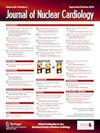根据糖尿病状态,心肌血流储备对已知无 CAD 患者的冠状动脉钙化、心肌灌注和临床变量的独立预后意义。
IF 3
4区 医学
Q2 CARDIAC & CARDIOVASCULAR SYSTEMS
引用次数: 0
摘要
目的:探讨无已知冠状动脉疾病(CAD)的糖尿病患者心肌血流储备(MFR)降低的患病率和预后差异。方法:在2,639例没有已知CAD的患者中,接受了铷正电子发射断层心肌灌注成像(MPI),其中818例(31%)患有糖尿病。MFR降低定义为MFR结果:在中位随访4.1年期间,发生574例(21.8%)ACD/MI(糖尿病患者204例(25.1%),非糖尿病患者370例(20.3%))。在多变量Cox分析中,MFR降低与糖尿病患者(每降低0.1:HR: 1.04, 95% CI: 1.02-1.06, P < 0.001)和非糖尿病患者(每降低0.1:HR: 1.03, 95% CI: 1.02-1.04, P < 0.001)的ACD/MI增加相关。无论CAC或缺血性负荷如何,糖尿病和MFR在ACD/MI风险方面不存在相互作用(均p < 0.05)。将MFR加入到临床、常规MPI结果和CAC的风险预测模型中,提高了两组患者对临床结果的辨别能力(DM: 0.003,非DM)。结论:MFR降低在糖尿病患者中更为常见,是CAC和临床变量的重要独立预后指标。无论CAC和缺血性负担如何,MFR和ACD/MI风险之间的相关性在有糖尿病和没有冠心病的患者之间没有差异。本文章由计算机程序翻译,如有差异,请以英文原文为准。
Independent prognostic significance of myocardial flow reserve over coronary artery calcium, myocardial perfusion, and clinical variables in patients without known coronary artery disease, according to diabetes status
Objective
To explore differences in prevalence and prognosis associated with reduced myocardial flow reserve (MFR) in patients without known coronary artery disease (CAD) based on diabetes status.
Methods
Of 2639 patients without known CAD who underwent rubidium positron emission tomography myocardial perfusion imaging (MPI), 818 patients (31%) had diabetes. Reduced MFR was defined as MFR <2.0. Coronary artery calcium (CAC) score was categorized as 0, 1-99, 100-399, and ≥400. Ischemic total perfusion deficit (TPD) was categorized as <1%, 1-<5%, and ≥5%. Outcome variables were all-cause death (ACD) and non-fatal myocardial infarction (MI).
Results
During the median follow-up of 4.1 years, 574 (21.8%) ACD/MI occurred (204 [25.1%] diabetic patients, 370 [20.3%] nondiabetic patients). In multivariable Cox analysis, reduced MFR was associated with increased ACD/MI in patients with diabetes (per .1 decrease: HR: 1.04, 95% CI: 1.02-1.06, P < .001) and patients without diabetes (per .1 decrease: HR: 1.03, 95% CI: 1.02-1.04, P < .001). No interaction existed between diabetes and MFR for ACD/MI risk regardless of CAC or ischemic burden (all P > .05). Adding MFR to the risk prediction model of clinical, conventional MPI findings, and CAC improved the discrimination for clinical outcomes in both groups (DM: .003, non-DM: <.001, respectively).
Conclusion
Reduced MFR was more common in patients with diabetes and an important independent prognostic marker over CAC and clinical variables. The association between MFR and ACD/MI risk did not differ between patients with and without diabetes who had no prior CAD, regardless of CAC and ischemic burden.
求助全文
通过发布文献求助,成功后即可免费获取论文全文。
去求助
来源期刊
CiteScore
5.30
自引率
20.80%
发文量
249
审稿时长
4-8 weeks
期刊介绍:
Journal of Nuclear Cardiology is the only journal in the world devoted to this dynamic and growing subspecialty. Physicians and technologists value the Journal not only for its peer-reviewed articles, but also for its timely discussions about the current and future role of nuclear cardiology. Original articles address all aspects of nuclear cardiology, including interpretation, diagnosis, imaging equipment, and use of radiopharmaceuticals. As the official publication of the American Society of Nuclear Cardiology, the Journal also brings readers the latest information emerging from the Society''s task forces and publishes guidelines and position papers as they are adopted.

 求助内容:
求助内容: 应助结果提醒方式:
应助结果提醒方式:


